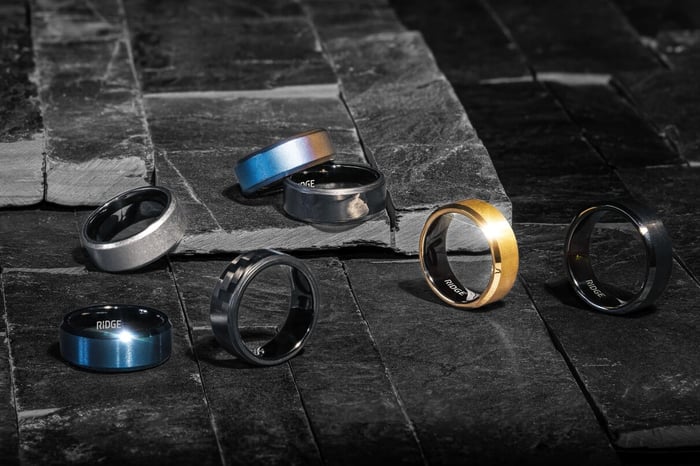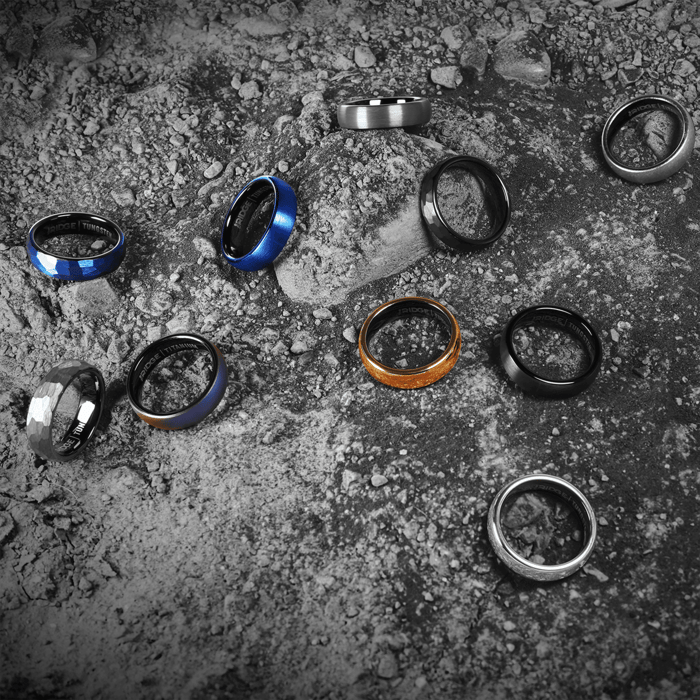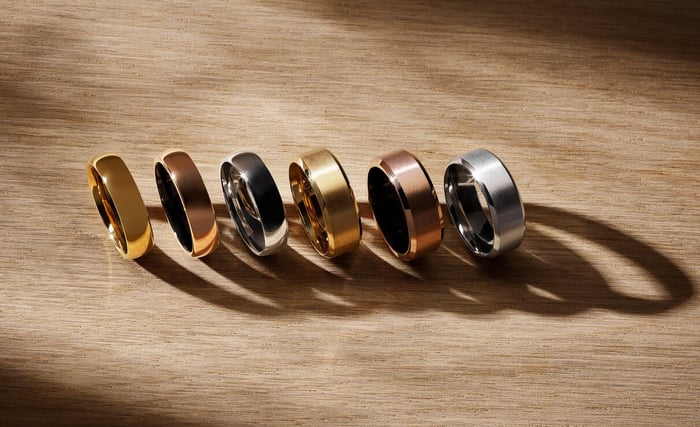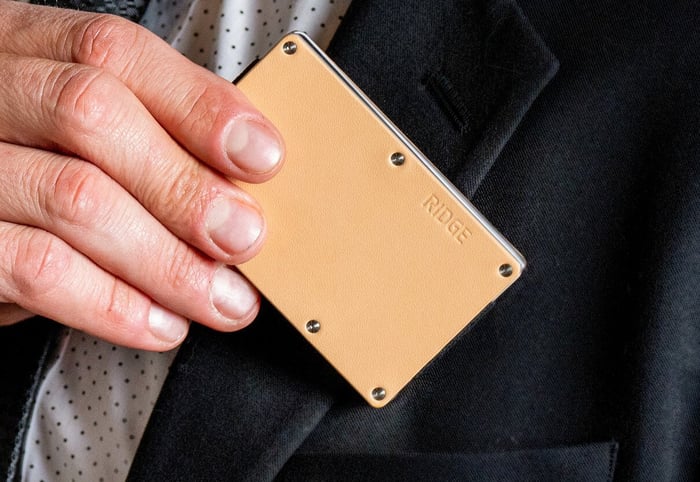With the abundance of different styles of wedding bands, making the right choice can be a challenge. It’s no longer a simple matter of just getting the classic gold wedding bands - today, your wedding ring can tell a tale of its own.
The selection of materials, shapes, styles, and finishes is constantly expanding. Luckily, this article will help you navigate the world of wedding bands easily. We’ll explore every facet of wedding rings and explain what you’ll get with different variants.
Popular Wedding Band Materials – Pros & Cons
Let’s start with reviewing the pros and cons of the most popular materials.

Exploring Different Shapes and Profiles
Modern wedding and engagement ring-making provides a variety of shapes and profiles that make the standard round shape more interesting. Here’s an overview of the most popular variants.
Flat Profile (Pipe Cut or Square Edge)
The flat profile is one of the classic variants. The surface of the ring is completely flat on both sides, giving a straightforward yet elegant look. Flat rings come in pipe cut and square edge options, with pipe cut having a somewhat softer edge compared to square.
This profile type is completely in contact with the finger, providing plenty of comfort and a snug fit.
Domed Profile or D-Shaped (Comfort Fit, Half-Round, or Court)
With an elegant, rounded surface, domed profiles are considered an evergreen ring design. Also known as d-shaped bands, these rings come in several variants depending on their inner side. Domed bands can be comfort fit, half-round, or court.
Of course, comfort fit will, as the name suggests, be the most comfortable option. Domed profiles are what most people think of in association with wedding bands.
Beveled Edge Profile
The beveled profile has distinct cut edges that give the impression of a rounded ring, although the band’s surface is practically flat. This type has a lower profile with a more updated look for the modern age.
Since beveled rings have a flat inner surface, they’ll fit similarly to flat rings while providing a unique style.
Concave Profile
Concave profiles have edges that curve outward. These bands represent something of a novelty, although they can look very elegant due to their uniqueness. A concave wedding band will undoubtedly stand out and may fit different hand shapes differently.
Concave profile rings are flat on the inside but looser on the edges. They’ll be comfortable to wear, although the curvature might represent an obstacle in everyday use.
Knife Edge Profile
Knife edge bands are slim, with two slopes that form the titular knife edge around the ring. These bands have a distinct look that shows elegance and a confident attitude. At the same time, this type of ring will blend in with various outfit styles.
A knife edge profile will be more suited for people with thinner fingers since these bands are usually thin themselves.
Milgrain Edge Profile
Milgrain edge men’s rings have a smooth surface with textured, coin-like edges. These rings can leave different impressions depending on their width. A wider milgrain ring will look more robust and, depending on the color, have a somewhat aggressive style. On the other hand, a slim milgrain band can look very delicate.
Grooved Profile
Faithful to its name, a grooved profile features one or more grooves that can be accentuated on both sides of the band or only appear on the surface. The grooved look is modern and will draw immediate attention.
Grooved profiles may seem outdoorsy and sports-like. However, thinner grooved rings will be very elegant and sophisticated.
Twisted or Braided Profile
Braided or twisted bands are a bold yet tasteful choice. As the name implies, these profiles look like strings of material that were actually braided into a distinct pattern. Depending on the braid width and color, these bands can brandish different looks, from subtle elegance to a rugged chain-like appearance.
The braiding can be only partial, at the top of the ring, as apparent on this gold diamond wedding band.
Ring Styles and Designs
Whether you’re going for gold, stainless steel, sterling silver, or platinum wedding bands, it’s important to know about the different styles and designs. The band’s design will ultimately make the difference between a ring you can call your own and one that has a generic appearance and doesn’t fit.
Your precious piece of jewelry may come in the following designs:
Classic: Plain and unadorned, these would be the pure gold wedding rings that you imagine upon hearing the words “wedding band.” Of course, the band can be made of other precious metals and materials while still belonging to this style.
Contemporary: This is a broader category of rings that may be minimalistic and modern in design. Choosing a contemporary band means you have an affinity toward unique, personalized styles that don’t necessarily conform to the traditional look.
Textured: Textured bands have distinct finishes (hammered finish, brushed finish, or sandblasted). In contrast to high-polish rings, the textured variant gives off a ruggedly personal touch. These bands may even feature completely unique textures.
Gemstone Accented: This wedding band style features diamonds or other precious stones that can be of various carat values. A wedding ring with a gemstone accent can follow a classical shape or have a more modern form.
Engraved: As the name says, engraved rings feature engravings, which can be personalized written messages, patterns, or specific imagery. For these bands, the jeweler often needs to do additional work on the piece since engraved rings usually aren’t pre-made.
Two-Tone or Mixed Metal: These bands are made of more than one precious metal. The rings can look very stylish and have a distinct feel to them, especially if the materials are carefully chosen. Two-tone rings can also feature other stylistic traits like gemstone accents or engravings.

Ring Finishes
In terms of finishes, wedding bands come in the following variants:
Polished finish
Satin finish
Hammered finish
Brushed finish
Of course, the polished finish is the smoothest, while the hammered variant is the harshest. Brushed and satin finishes are increasingly popular due to their subtle yet eye-catching looks.
Selecting the Ideal Ring Width
The width of a men’s wedding band is a matter of comfort and personal preference. Typically, men’s rings range in width from 2-10mm, with wider rings being considered somewhat extreme.
The important factors in choosing the right width include:
Finger size
Occupation
Personal style
Finger size will be crucial here, as people with shorter fingers would find wide rings particularly ill-fitting. In terms of occupation, those working with their hands will need to choose the ring width carefully - extremely thin rings may be too brittle, while wider bands could get in the way during manual work.
Finally, personal style is just that – a matter of preference. It’s worth noting that wider bands will be more pronounced, while thinner options will be discrete.
Choosing the Right Fit
Finding a band that will fit on your ring finger snuggly is just as important as choosing a design you like. Different profiles like flat, domed, or beveled reflect on comfort in various ways, with the more rounded, smooth shapes usually being more comfortable.
However, there are wedding bands specifically designed to maximize comfort. Unsurprisingly, these are called “comfort fit” rings. These bands have rounded interior surfaces, which means they require more material to make. As a result, comfort fit bands are usually more expensive, but they provide a superior feeling when worn.
When it comes to ring size, you’ll need to determine it as precisely as possible. An ill-fitting ring will either move around on your finger or be too tight, neither of which is ideal. To find your ideal fit, use this ring sizer chart from Ridge.
Customizing Your Wedding Band
You can personalize your wedding band, making it truly your own. Here are the most common methods of wedding band customization:
Engraving: Your ring can be engraved with a personalized message or custom imagery on the outside or inside surface.
Unique finishes or textures: You can choose the finish or texture for your wedding ring depending on your style.
Custom designs or patterns: While pricey, custom designs are among the best ways to personalize a wedding band. The material might be a limiting factor here but other than that, your imagination will be the limit.
Adding gemstones: A classic method of band customization, adding gemstones is a timeless tradition that still leaves plenty of space for personalization.
Caring for Your Wedding Band
The particular cleaning methods for wedding bands may vary depending on the material. However, your safest bet will always be to clean your wedding band with soap and warm water. Note that the soap should be mild – most wedding bands don’t react well to aggressive chemicals.
If you notice damage, gemstones coming loose, or persistent staining, it would be best to take your ring to a professional. They can repair or clean the ring properly. But even if you don’t notice any alarming signs, having a yearly checkup will help prevent damage.
Define Your Style With Ridge
Choosing a wedding band isn’t as simple a task as you might presume. You need to consider the shape, style, material, and customization options for your ring, which means you need to find a manufacturer with the best options in the market.
Ridge has everything you need, from more affordable yet quality-made bands to exclusive, tailored items. Browse our selection and find a wedding band that will complement your style and serve as a symbol of commitment that everyone will admire.
FAQs
What is in style for mens wedding bands?
Although the choice of a wedding band is quite personal, certain styles are more popular than others today. For instance, a matte finish is considered very stylish, and you can see plenty of men wearing a flat ring design. White metal is also an interesting option that’s becoming more prominent.
What color should a man's wedding band be?
Traditionally, most wedding rings were made of white or yellow gold. While these variants are viewed as timeless, novel materials like tungsten and palladium open the palette. Today, darker rings represent a popular choice, rivaling the traditional options.
Should men wedding band be thick or thin?
There’s no rule about the thickness of a wedding ring. While thin variants are often viewed as more stylish, wider bands can fit into the personal style nicely, especially with the right choice of material. Furthermore, men’s wedding rings come in a variety of styles that accommodate thick and thin options.
Why are men wearing dark wedding bands?
Darker men’s wedding band styles have become increasingly popular. It’s no longer the case that yellow or white gold or silver are deemed must-have options, so men (and women)are branching out into less traditional styles.

Evan Grimm, Writer
Evan Grimm is a practical writer, blogger, editor, and knowledgeable up-and-coming authority in the outdoor realm. His best-known content is published on Bowhunting.com, The Alaska Frontier, and Exodus Outdoor Gear. He and his family reside in central Alaska, where daily common sense and practicality are necessary. His commercial pilot and aircraft technician certifications make him focus on what is relevant and solidly provable. You will find him writing or proving more content.













































